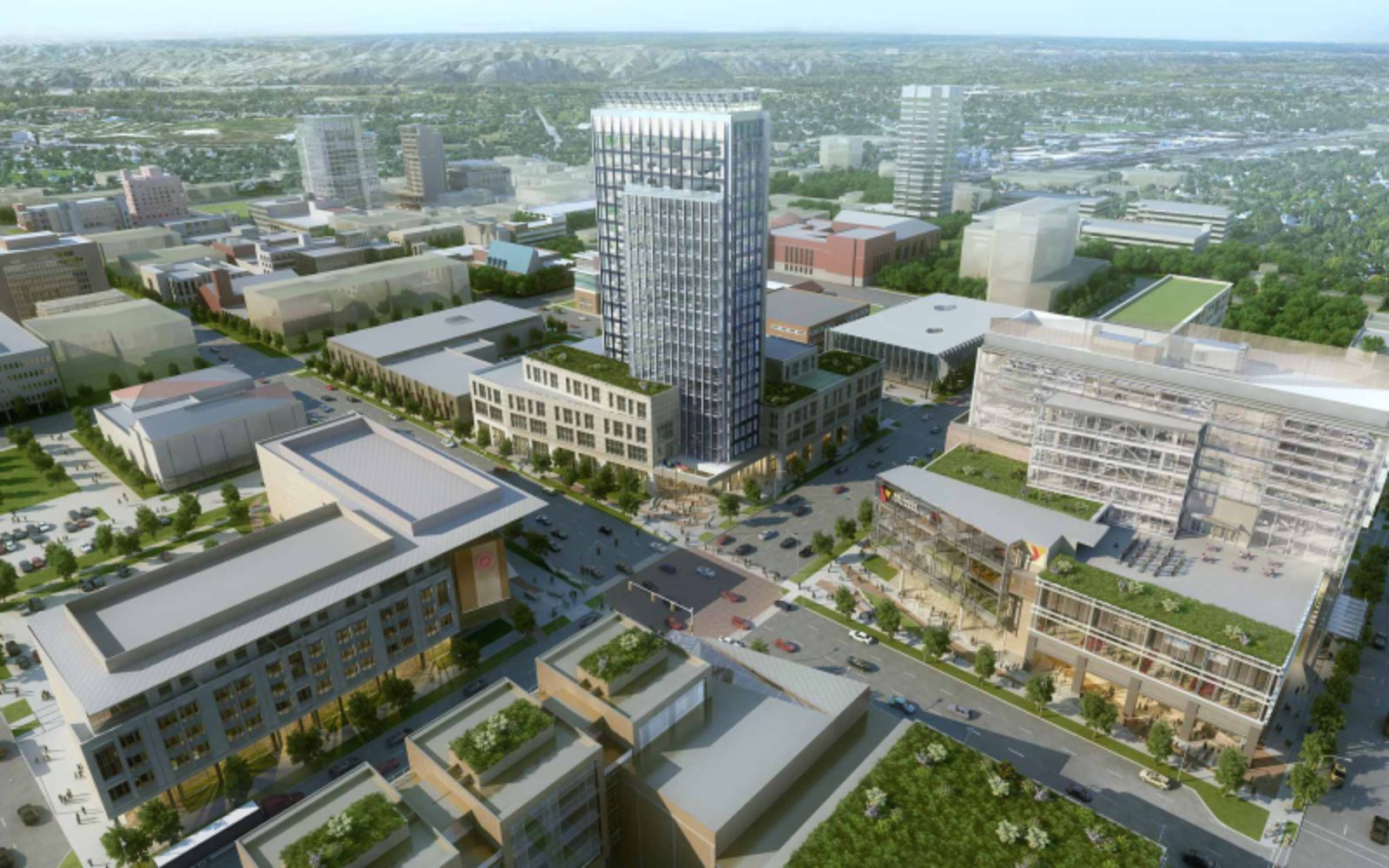Last month, the Intergovernmental Panel on Climate Change (IPCC) released its latest report on the state of the warming planet, stating: “It is unequivocal that human influence has warmed the atmosphere, ocean, and land.” Findings from the report — approved by 195 governments and based on more than 14,000 studies — also showed that aggressive, rapid, and widespread cuts to greenhouse gas (GHG) emissions, if they begin immediately, could limit warming beyond 2050.
Yet, when we think of cutting emissions, a sparkling new subdivision or a stop at the supermarket on the commute home from the office may not come to mind. We’re more likely to envision congested freeways, overpopulated cities, heavy resource extraction, and industrial smokestacks. However, accommodating urban sprawl — necessitating new buildings, more driving, and larger parking lots — is a major contributor of GHG emissions.

What we likely default to considering is how the changing climate affects where and how we live, work, and play — not the other way around. We focus on how a flood could knock out power to the supermarket or how a fire could damage our home. But the reality is, the ways in which we develop and use land play a big role in how these places are impacted.
Reversing the Trend
Another paper published in the spring specifically explored the possibility of turning the tide of climate change by way of sustainable land use. The authors of the report, published by the Brookings Institution, detail how decades of sprawl have made the U.S. a world leader in both building-related energy consumption and vehicle miles traveled per capita. Additionally, they found that lower-density development can pollute water sources and result in higher relative emissions during initial construction.

The trend toward urban sprawl is largely driven by people’s preferences for low-density residential areas. Contributing factors include the benefits of newer homes and subsequent home value, nearby shopping, better schools, and greater security (whether real or perceived). Now, we need to go deeper than all-electric homes, solar panels, and recycled materials; we need to focus on why, where, and how to build in general. This means rethinking the entire planning, design, and construction process as well as changing local development regulations and policies that currently promote urban sprawl development patterns.
What can be done now to make positive change for future generations?
1) Land-use planning: Cities, counties, and communities can focus on changing land-use planning strategies and guide growth and development toward compact, vertical, walkable neighborhoods and districts. Communities can rethink annexation policies to control how growth is defined, spurring enclaves or cluster developments that preserve and encourage open spaces and agricultural lands that help eliminate food deserts.

2) Education: The design, planning, and development community can help educate people about how such changes will make a difference and provide benefits, and we can demonstrate the logistics of how to design and build in denser environments. We can show how regenerative and resilient design that encourages human-centered solutions is not only doable, but imperative.
3) Partnerships: In addition to simply understanding that urban sprawl is problematic for the environment, we need to dig into how and why. This is where a variety of experiences and expertise comes into play. Not only can design firms tap into the variety of resources they may have in-house, but also partner with city leaders, developers, and financing institutions. Partnerships are key to understanding land use needs and solutions, as well as helping to drive policies that encourage more climate-friendly development.

4) Walking the walk: As we aim to design and build more sustainably, there will be choices we have to make related to both money and morals. Design firms will have to be clear on their mission: What is it that we truly believe in? Because the conversation about urban sprawl and climate change also includes discussions about equity and social justice. And of course, there’s the monetary investment — putting our money where our morals are.
Understanding the Problem of Urban Sprawl
While the thought of pollution may bring densely packed urban cores to mind, research suggests these areas have lower levels per capita of GHG emissions and other pollutants, compared to their less-dense neighbors. The key difference being that in older urban locales, the living spaces and city blocks tend to be smaller, promoting cleaner modes of movement such as walking and biking.

Although design firms have pioneered and adopted ways to make buildings greener, development in car-dependent areas often incentivizes less energy-efficient design. Even constructing these low-density neighborhoods requires more physical capital per person, which translates into more building materials and emissions to manufacture the necessary concrete, asphalt, piping, and other inputs — and all such materials can radiate heat back into the atmosphere to cause higher temperatures.
There are still plenty of people who will argue for the individual benefits of living in less-dense regions, such as lower noise or light pollution, but there’s also research that negates many of the misconceptions of living in dense urban areas. One recent study found that large U.S. cities have lower rates of depression because of the number and variety of human social networks available to them — running counter to the popular belief that these regions can feel cold and isolating. It’s just one more reason that stopping sprawl can be good for both people and the planet.

Solutions Through Human-Centered Development
Battling climate change through design, while having obvious implications for land use, is about centering development on the users. Designing for people’s well-being tends to result in more conscious, sustainable design. Similarly, if you solve for a warming planet, you make the world more livable for its inhabitants. To realize better places for people, as well as reduce our impact on the earth, there must be a focus on 1) high-performance buildings, 2) mobility, and 3) compact communities.
Work has progressed (and continues to progress) on the first aspect, designing and building high-performance buildings. Look no further than the influx of LEED (Leadership in Energy and Environmental Design), Green Globes, WELL, and other certifications as proof — not to mention the strong push from businesses, cities, and developers to realize energy-efficient, resilient buildings that result in cost-savings.

Sustainability in Reimagining What Already Exists
Reimagining design in dense regions includes reimagining our existing spaces. Rather than constructing a new building, we can think about reusing existing structures. This strategy is tied to the concept of a circular economy, one that feeds and sustains itself rather than seeking out new sources of energy, materials, or land once the old ones have been depleted. Reusing existing structures also can reduce embodied carbon.
This is the carbon footprint of a building or infrastructure project unrelated to its operation and including the carbon dioxide produced to build, maintain, and eventually demolish it and dispose of the waste materials. While “starting from scratch” may feel like the easier option, solutions such as adaptive reuse can have enormous economic upsides. Land assemblage and new, walkable infill dedicated to a mix of uses and located near public transit is another plausible strategy.

Revitalizing urban areas can draw more residents and visitors, thus increasing the value of nearby properties and boosting local tax revenues. The benefits to cities are so high that some are starting to incentivize the reuse of old properties, such as increased density allowances and flexible approval and permitting processes — all of which can save investors time and money. Making communities and neighborhoods more walkable can result in more room for green space with health benefits for both humans and the earth.
Adding more trees that provide shade mitigates the urban heat island effect, wherein dense concentrations of pavement, buildings, and other surfaces absorb and retain heat. Certain natural landscapes actually serve as carbon sinks, defined as areas that absorb more carbon from the atmosphere than they release. Protecting these environments from development and sprawl not only stops further climate change, but also helps repair the damage we’ve already done. Source and images Courtesy of Cushing Terrell.

